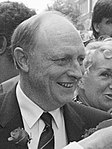United Kingdom local elections, 1990
|
|
|||||||||||||||||||||||||||||||||
|---|---|---|---|---|---|---|---|---|---|---|---|---|---|---|---|---|---|---|---|---|---|---|---|---|---|---|---|---|---|---|---|---|---|
|
|||||||||||||||||||||||||||||||||
|
All 32 London boroughs, all 36 metropolitan boroughs, 116 out of 296 English districts and all 12 Scottish regions |
|||||||||||||||||||||||||||||||||
|
|||||||||||||||||||||||||||||||||
Local elections were held in the United Kingdom on 3 May 1990. They were the last local elections held before the resignation of Prime Minister Margaret Thatcher in November 1990.
The main opposition Labour Party gained 284 seats, bringing their number of councillors to 8,920 - their highest since 1981. Their projected share of the vote was 44%, an increase of 2% from 1989.
The governing Conservative Party lost 222 seats, leaving them with 9,020 councillors. Their share of the vote was projected to be 33%, a fall of 3% from the previous year. This mounted further pressure on the government of Margaret Thatcher, which had been declining for a year following the introduction of the controversial poll tax, and was a major boost for opposition leader Neil Kinnock, whose Labour Party was enjoying a wide lead in the opinion polls with a general election no more than two years away.
The Liberal Democrats lost 78 seats and had 3,265 councillors after the elections. Their projected share of the vote was 17%.
In all 32 London boroughs the whole council was up for election.
All 36 metropolitan borough councils had one third of their seats up for election.
In 2 districts the whole council was up for election.
In 2 districts there were new ward boundaries, following further electoral boundary reviews by the Local Government Boundary Commission for England.
‡ New ward boundaries
In 114 districts one third of the council was up for election.
...
Wikipedia



